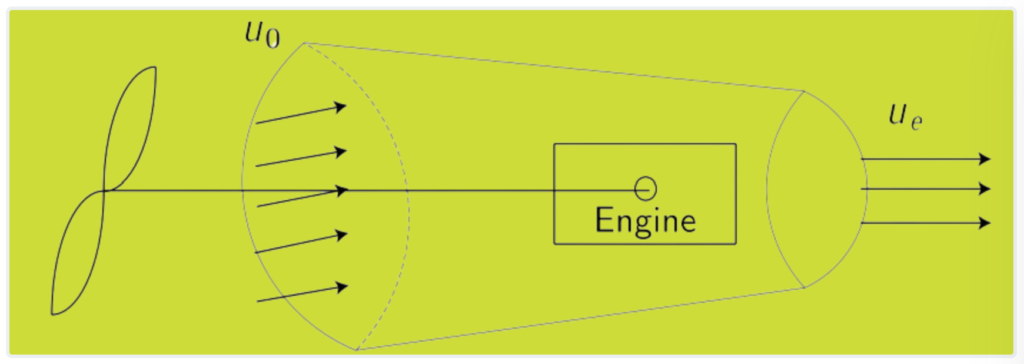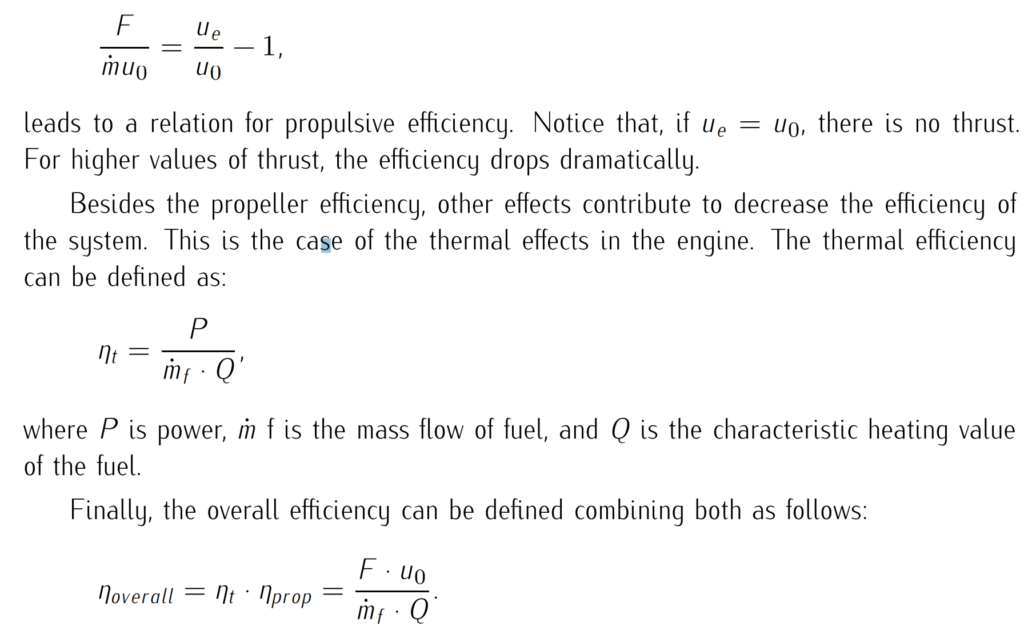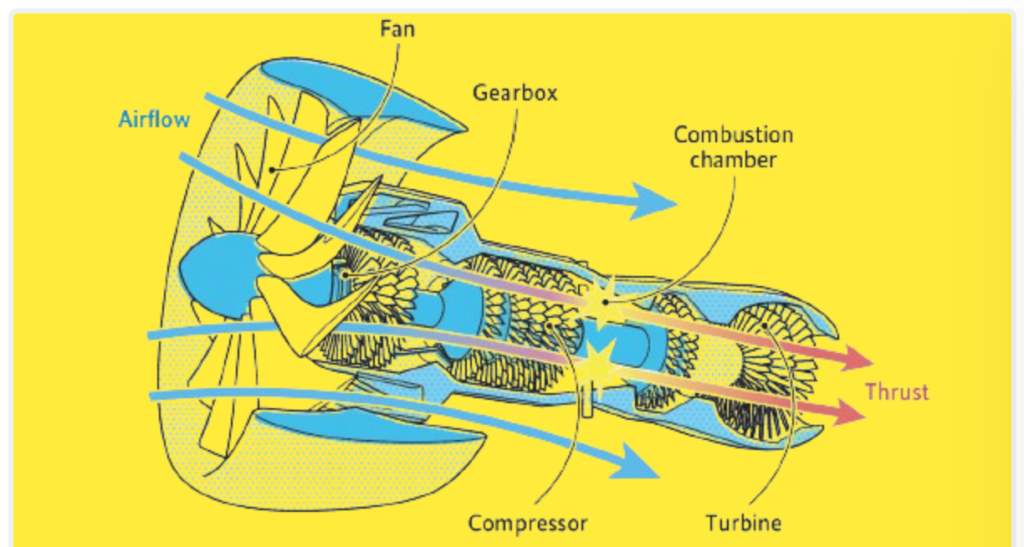A propeller is a type of rotating airfoil or blade that generates thrust to propel an aircraft through the air. It consists of one or more blades attached to a central hub, which is typically connected to an engine or motor. When the propeller rotates, it creates a pressure difference between the front and back surfaces of the blades, generating thrust by accelerating air in the direction opposite to its rotation.
Propellers are commonly used on aircraft with piston engines, turboprop engines, or electric motors, as well as on boats and other vehicles requiring propulsion through air or water. They come in various designs, including fixed-pitch, variable-pitch, and controllable-pitch propellers, each offering different performance characteristics and capabilities. Propellers play a vital role in aircraft propulsion, providing the necessary thrust for takeoff, climb, cruise, and descent phases of flight.
What is Aircraft Propulsion and Propeller?
Aircraft propulsion systems, whether propeller engines or jet engines, operate based on the principle of accelerating airflow to generate thrust. Propeller engines achieve this by using rotating blades to push air backwards, while jet engines rely on the expansion of exhaust gases expelled at high velocity to produce thrust. Rocket engines, though not used in conventional aircraft, operate similarly by expelling combustion gases at high speeds to propel the spacecraft forward.
The design of an aircraft engine must meet various requirements, including providing sufficient thrust to overcome aerodynamic drag and accelerate the aircraft. Additionally, engines must meet operational needs such as climbing, turning, and maintaining speed. Commercial aircraft engines prioritize efficiency and low fuel consumption, whereas fighter aircraft engines may prioritize high thrust for maneuverability in combat situations. Overall, aircraft engines play a critical role in achieving optimal performance and meeting the diverse operational demands of different aircraft types.
What is Propeller?
The propeller, commonly used in general aviation aircraft powered by internal combustion piston engines, operates on fundamental aerodynamic principles. Air enters the engine, where it mixes with fuel and undergoes combustion, releasing energy that drives a piston attached to a crankshaft. This rotational motion of the crankshaft is then transmitted to the propeller, causing it to rotate.
Contrary to popular belief, the combustion process in the engine itself contributes very little to the generation of thrust. Instead, the primary source of thrust is the propeller’s aerodynamic action. Propellers typically feature two, three, or four blades with airfoil-shaped profiles. As the propeller rotates, it functions similarly to a rotating wing, creating lift due to its motion through the air. While the aerodynamics of propeller blades differ somewhat from those of fixed-wing aircraft, the underlying principles remain consistent: the engine drives the propeller, creating a significant pressure differential across the blades, ultimately resulting in a forward thrust force.

Propeller Propulsion Equations
The propulsion system of a propeller-driven aircraft operates based on principles derived from Newton’s equations of motion and the conservation of energy and momentum. The thrust force generated by the propeller is determined by the mass flow rate of air and the difference in velocities between the inlet and outlet of the propeller. Additionally, the output power of the propeller, representing the kinetic energy flow, is calculated based on the difference in squared velocities.

In propeller propulsion systems, u0 represents the inlet velocity of air entering the propeller, ue denotes the exit velocity of air leaving the propeller, and ˙m˙ represents the mass flow rate of air through the propeller. It’s important to note that the exit velocity ue is typically higher than the inlet velocity u0 because the air undergoes acceleration within the propeller due to the conversion of energy.
According to the conservation of energy principle for ideal systems, the output power of the propeller can be equated to the kinetic energy flow across the propeller. Mathematically, this relationship is expressed as:

In propeller propulsion systems, F⋅u0 represents the useful work done by the propeller, where F is the thrust force generated and ( u_0 ) is the inlet velocity of air entering the propeller. On the other hand, ( P ) refers to the input power required by the engine, representing the total power consumed by the engine to produce thrust. In essence, the efficiency η of the propeller system is defined as the ratio between the real output power generated to move the aircraft (useful work) and the input power demanded by the engine to produce this work.
In an ideal system where there are no losses, F⋅u0 would equal P, meaning that all the input power is effectively converted into useful work. However, in real-world systems, factors such as mechanical losses in transmissions and other inefficiencies result in F⋅u0 being less than P. As a result, the efficiency of the propeller system η is reduced from its theoretical maximum, reflecting the practical limitations and inefficiencies inherent in real propulsion systems.
Operating Above Equations.

In the pursuit of achieving high efficiency (ηprop∼1), it’s desirable to minimize the difference between the exit velocity ue and the inlet velocity (u0). However, according to Equation (6.1), when the inlet and exit velocities are very close, a significantly larger mass flow rate (˙m˙) is required to generate the desired thrust force. This implies that there are inherent limits on how efficient an aircraft engine can be, as optimizing for one parameter may necessitate compromising on another.
By rearranging Equation, we can express the propulsive efficiency (ηprop) as:

What is Aircraft Propulsion?
The main types of aircraft propulsion systems include:
Propeller Engines: Propeller-driven aircraft use internal combustion piston engines or turboprop engines to drive a propeller. The propeller generates thrust by accelerating air rearward, similar to how a rotating wing generates lift. These engines are commonly used in general aviation aircraft and some regional airliners.
Jet Engines: Jet engines, including turbojet, turbofan, and turboprop engines, are widely used in commercial and military aviation. These engines operate on the principle of jet propulsion, where air is drawn into the engine, compressed, mixed with fuel, ignited, and expelled at high velocity through a nozzle, generating thrust. Jet engines offer high power-to-weight ratios and are capable of powering aircraft at high speeds and altitudes.
Rocket Engines: Rocket engines are used in spacecraft and high-speed aircraft to achieve propulsion in the vacuum of space or in the upper atmosphere. Unlike air-breathing engines, rocket engines carry their own oxidizer and burn fuel internally, producing thrust by expelling exhaust gases at high speeds.
Each type of propulsion system has its own advantages and limitations, influencing factors such as aircraft performance, range, speed, efficiency, and mission capabilities. Advances in propulsion technology continue to drive innovation in aircraft design, enabling the development of faster, more efficient, and environmentally friendly aircraft for diverse aviation applications.
